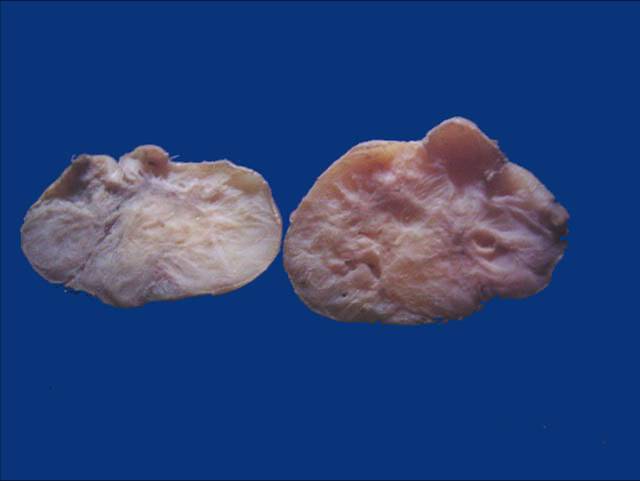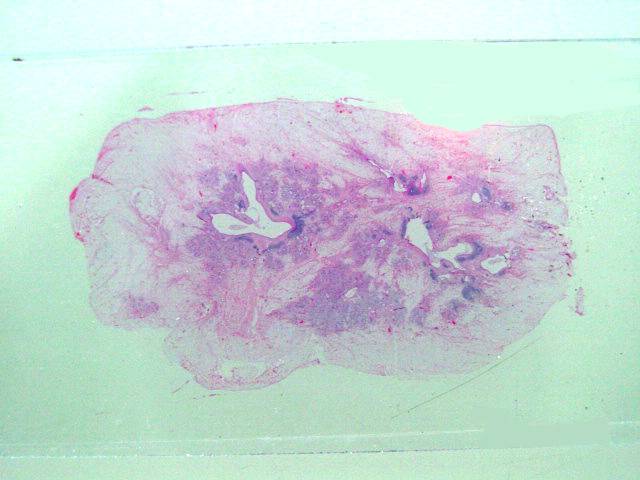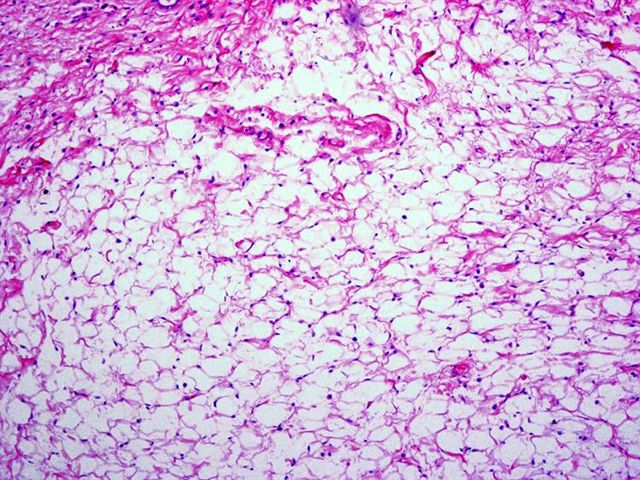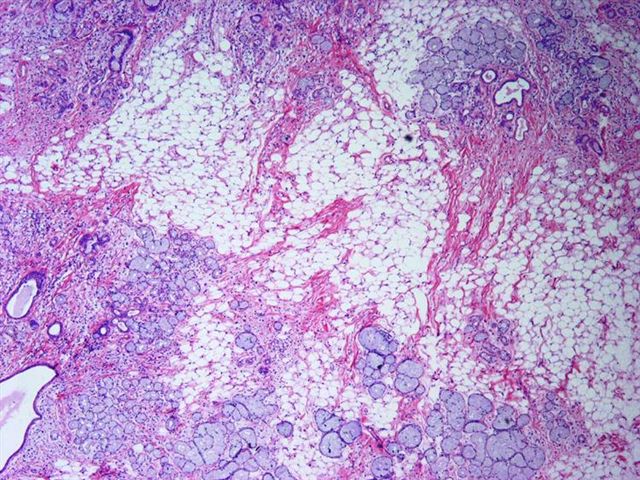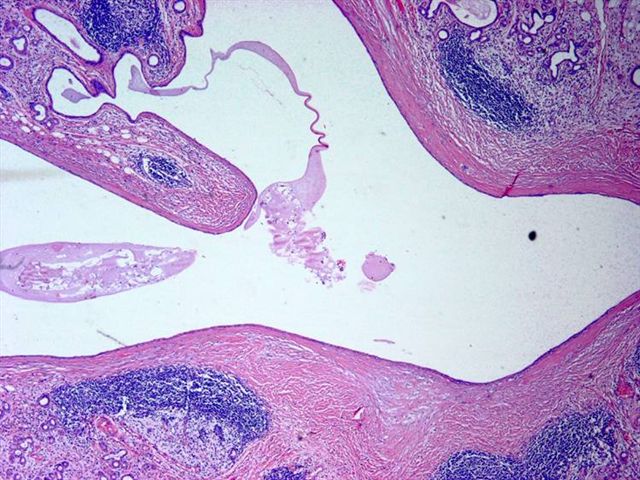14 June 2006 - Case #49
All cases are archived on our website. To view them sorted by case number, diagnosis or category, visit our main Case of the Month page. To subscribe or unsubscribe to Case of the Month or our other email lists, click here.
This case was contributed by Dr. Juan Jose Segura Fonseca, Hospital San Juan de Dios, Costa Rica.

Case #49
Clinical history:
A 68 year old woman was seen in the outpatient clinic because of difficulty in swallowing and sensation of a large foreign body in her throat, of several months duration. On physical examination, a large, solid, pale yellow tumor was located in the soft palate. Complete resection of a large lipoma-like tumor mass was performed.
Microscopic findings:
On low power (image 3), a tumor characterized by peripheral lipomatous tissue and central salivary gland elements with prominent dilation of ducts is seen. In the periphery, there is a predominance of adipose tissue that looks like a lipoma (image 4). In the central area, there is a mixture of adipose tissue, fibrous trabeculae and numerous salivary gland acini. Some dilated ducts are also seen (image 5). Other areas show acinar predominance and numerous ectatic ducts lined by flat cuboidal epithelium (image 6). Numerous dilated ducts are arranged in a lobular-like structure with prominent fibrosis (image 7).
Focally, there is marked dilatation of ducts with prominent fibrosis of the wall infiltrated by nodular aggregates of lymphocytes, resembling small lymphoepithelial cysts (image 8, image 9).
Gross images:
Microscopic images:
What is your diagnosis?
Diagnosis: Sialolipoma of the soft palate
Discussion:
Intraoral lipoma is a well known entity but lipomatous tumors including salivary gland tissue containing clustered or peripherally located ducts in acinar glandular tissue are uncommon (Ellis: Tumors of the Salivary Glands, Series 3, 1996, Oral Surg Oral Med Oral Pathol 1971;31:511). Under the designation of sialolipoma, Nagao et al. from Japan described a new variant of salivary gland lipomatous tumor (Histopathology 2001;38:30). They reported 7 cases, 5 men and 2 women, aged 20 - 75 years old. 5 tumors were located in the parotid gland, 1 in the hard palate and 1 in the soft palate.
Grossly, the tumors were well circumscribed and resembled an ordinary lipoma. Histologically, they were characterized by a proliferation of mature adipose tissue intermingled with acinar, ductal, basal and myoepithelial cells of normal salivary gland. Duct ectasia with fibrosis and prominent lymphoid infiltrates with nodular aggregates in the stroma is a constant finding.
These tumors have benign behavior. No recurrences have been noted, including from recent reports in the floor of the mouth or the parotid gland (Kaohsiung J Med Sci 2004;20:410, J Craniomaxillofac Surg 2006;34:43).
This case corresponds to the fourth reported case of sialolipoma located in the oral cavity and the second in the soft palate.
References: Ellis: Tumors of the Salivary Glands, Series 3, 1996, Oral Surg Oral Med Oral Pathol 1971;31:511, Histopathology 2001;38:30, Kaohsiung J Med Sci 2004;20:410, J Craniomaxillofac Surg 2006;34:43
All cases are archived on our website. To view them sorted by case number, diagnosis or category, visit our main Case of the Month page. To subscribe or unsubscribe to Case of the Month or our other email lists, click here.
This case was contributed by Dr. Juan Jose Segura Fonseca, Hospital San Juan de Dios, Costa Rica.

Website news:
(1) This Case is sponsored by Sakura Finetek, USA. Leading the revolution in Pathology, the Tissue-Tek Xpress Rapid Tissue Processor is helping laboratories achieve new levels of productivity. Enabling a continuous flow of up to 40 cassettes every 15 minutes, this system can process up to 120 specimens per hour. The Xpress allows for a balanced distribution of work throughout the day, eliminating bottlenecks and batches common with overnight processing. Improved turnaround times, reduced waste and increased productivity are just a few benefits this technology can offer your lab. Results are the same or better than overnight processing. Help your lab reach its full potential with the Tissue-Tek Xpress Rapid Tissue Processor. For more information, contact Ms. Elise Green, Marketing Manager at 1-800-725-8723 extension 7873 or at egreen@sakuraus.com.
Visit and follow our Blog to see recent updates to the website.
(1) This Case is sponsored by Sakura Finetek, USA. Leading the revolution in Pathology, the Tissue-Tek Xpress Rapid Tissue Processor is helping laboratories achieve new levels of productivity. Enabling a continuous flow of up to 40 cassettes every 15 minutes, this system can process up to 120 specimens per hour. The Xpress allows for a balanced distribution of work throughout the day, eliminating bottlenecks and batches common with overnight processing. Improved turnaround times, reduced waste and increased productivity are just a few benefits this technology can offer your lab. Results are the same or better than overnight processing. Help your lab reach its full potential with the Tissue-Tek Xpress Rapid Tissue Processor. For more information, contact Ms. Elise Green, Marketing Manager at 1-800-725-8723 extension 7873 or at egreen@sakuraus.com.
Visit and follow our Blog to see recent updates to the website.
Case #49
Clinical history:
A 68 year old woman was seen in the outpatient clinic because of difficulty in swallowing and sensation of a large foreign body in her throat, of several months duration. On physical examination, a large, solid, pale yellow tumor was located in the soft palate. Complete resection of a large lipoma-like tumor mass was performed.
Microscopic findings:
On low power (image 3), a tumor characterized by peripheral lipomatous tissue and central salivary gland elements with prominent dilation of ducts is seen. In the periphery, there is a predominance of adipose tissue that looks like a lipoma (image 4). In the central area, there is a mixture of adipose tissue, fibrous trabeculae and numerous salivary gland acini. Some dilated ducts are also seen (image 5). Other areas show acinar predominance and numerous ectatic ducts lined by flat cuboidal epithelium (image 6). Numerous dilated ducts are arranged in a lobular-like structure with prominent fibrosis (image 7).
Focally, there is marked dilatation of ducts with prominent fibrosis of the wall infiltrated by nodular aggregates of lymphocytes, resembling small lymphoepithelial cysts (image 8, image 9).
Gross images:
Microscopic images:
What is your diagnosis?
Click here for diagnosis and discussion:
Diagnosis: Sialolipoma of the soft palate
Discussion:
Intraoral lipoma is a well known entity but lipomatous tumors including salivary gland tissue containing clustered or peripherally located ducts in acinar glandular tissue are uncommon (Ellis: Tumors of the Salivary Glands, Series 3, 1996, Oral Surg Oral Med Oral Pathol 1971;31:511). Under the designation of sialolipoma, Nagao et al. from Japan described a new variant of salivary gland lipomatous tumor (Histopathology 2001;38:30). They reported 7 cases, 5 men and 2 women, aged 20 - 75 years old. 5 tumors were located in the parotid gland, 1 in the hard palate and 1 in the soft palate.
Grossly, the tumors were well circumscribed and resembled an ordinary lipoma. Histologically, they were characterized by a proliferation of mature adipose tissue intermingled with acinar, ductal, basal and myoepithelial cells of normal salivary gland. Duct ectasia with fibrosis and prominent lymphoid infiltrates with nodular aggregates in the stroma is a constant finding.
These tumors have benign behavior. No recurrences have been noted, including from recent reports in the floor of the mouth or the parotid gland (Kaohsiung J Med Sci 2004;20:410, J Craniomaxillofac Surg 2006;34:43).
This case corresponds to the fourth reported case of sialolipoma located in the oral cavity and the second in the soft palate.
References: Ellis: Tumors of the Salivary Glands, Series 3, 1996, Oral Surg Oral Med Oral Pathol 1971;31:511, Histopathology 2001;38:30, Kaohsiung J Med Sci 2004;20:410, J Craniomaxillofac Surg 2006;34:43


